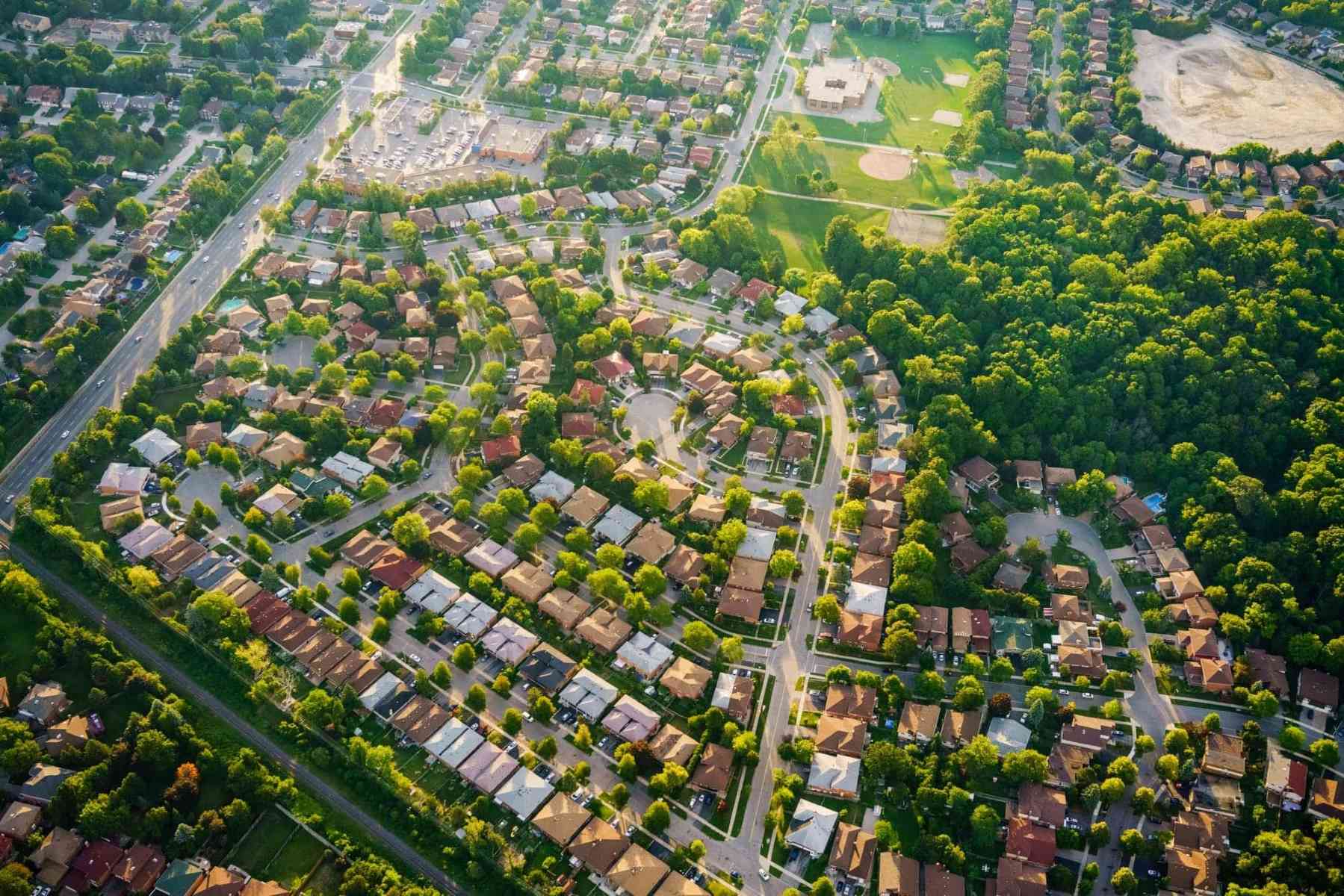Home>Education>Discover The Key Distinctions Between Urban, Suburban, Rural Areas, And Neighborhoods


Education
Discover The Key Distinctions Between Urban, Suburban, Rural Areas, And Neighborhoods
Published: February 21, 2024
Explore the differences between urban, suburban, and rural areas and neighborhoods. Learn how education varies across different community settings.
(Many of the links in this article redirect to a specific reviewed product. Your purchase of these products through affiliate links helps to generate commission for Regretless.com, at no extra cost. Learn more)
Introduction
Understanding the distinctions between urban, suburban, and rural areas, as well as neighborhoods, is essential for gaining insight into the diverse landscapes that shape our communities. Each of these settings possesses unique characteristics that influence the lifestyles, opportunities, and experiences of the individuals residing within them. By delving into the defining features of these environments, we can gain a deeper appreciation for the multifaceted nature of human habitation.
The term "urban" typically evokes images of bustling cityscapes, characterized by towering skyscrapers, vibrant cultural scenes, and a fast-paced way of life. In contrast, "suburban" areas are often associated with a more tranquil atmosphere, featuring spacious residential neighborhoods, local amenities, and a balance between urban conveniences and natural surroundings. Meanwhile, "rural" areas conjure up visions of expansive farmlands, serene countryside vistas, and a close-knit community spirit.
Furthermore, the concept of "neighborhoods" encompasses microcosms within these broader categories, where individuals form close-knit communities and establish unique identities within the larger urban, suburban, or rural landscape. These neighborhoods often showcase distinct architectural styles, cultural influences, and communal activities, contributing to the rich tapestry of human interaction and coexistence.
By exploring the defining characteristics of urban, suburban, and rural areas, as well as the intricate dynamics of neighborhoods, we can gain a comprehensive understanding of the diverse environments that shape our daily lives. This exploration will shed light on the varied opportunities, challenges, and cultural nuances that define each setting, ultimately enriching our appreciation for the multifaceted tapestry of human habitation.
Urban Areas
Urban areas are vibrant, densely populated regions that serve as epicenters of cultural, economic, and social activity. These bustling environments are characterized by towering skyscrapers, bustling streets, and a diverse array of architectural marvels that shape the iconic cityscape. The urban landscape is adorned with a rich tapestry of cultural institutions, including museums, theaters, art galleries, and concert halls, offering a plethora of opportunities for artistic enrichment and intellectual stimulation.
In addition to their cultural significance, urban areas are renowned for their economic dynamism, serving as hubs for commerce, finance, and innovation. These bustling centers are home to multinational corporations, startups, and entrepreneurial ventures, fostering an environment of creativity, collaboration, and economic growth. The urban landscape is dotted with towering office buildings, where professionals from diverse industries converge to drive forward the engines of progress and prosperity.
Moreover, urban areas are synonymous with diversity, attracting individuals from various cultural, ethnic, and socioeconomic backgrounds. This amalgamation of perspectives and experiences contributes to the vibrant tapestry of urban life, fostering a rich mosaic of traditions, languages, and culinary delights. The streets of urban areas resonate with the harmonious blend of different cultures, creating a melting pot of human experiences and interactions.
Furthermore, the infrastructure of urban areas is meticulously designed to cater to the needs of its inhabitants. Efficient public transportation systems, including subways, buses, and trains, facilitate seamless mobility within the city, connecting residents to employment opportunities, educational institutions, and recreational venues. Additionally, urban areas boast a plethora of dining establishments, ranging from Michelin-starred restaurants to quaint cafes, offering a diverse culinary landscape that caters to every palate.
The allure of urban areas extends beyond their economic and cultural significance, as they also serve as incubators for innovation and technological advancement. These dynamic environments are at the forefront of scientific research, technological breakthroughs, and sustainable urban development initiatives, shaping the future of human civilization.
In essence, urban areas stand as testaments to human ingenuity, creativity, and resilience, embodying the spirit of progress and innovation. Their bustling streets, towering skyscrapers, and vibrant cultural scenes converge to form the beating heart of modern civilization, offering a kaleidoscope of experiences and opportunities for those who call these dynamic environments home.
Suburban Areas
Suburban areas represent a harmonious blend of urban convenience and rural tranquility, offering residents a serene retreat from the bustling city while providing easy access to essential amenities. These idyllic neighborhoods are characterized by spacious residential properties, tree-lined streets, and a strong sense of community, fostering a tranquil and family-friendly atmosphere.
One of the defining features of suburban areas is the abundance of green spaces and recreational facilities, providing residents with opportunities to immerse themselves in nature and engage in outdoor activities. Parks, playgrounds, and walking trails are interspersed throughout these neighborhoods, offering a picturesque backdrop for leisurely strolls, family picnics, and community gatherings. The presence of these natural havens contributes to the overall well-being of suburban residents, promoting an active and healthy lifestyle.
Moreover, suburban areas boast a diverse array of local amenities, including shopping centers, grocery stores, and small businesses, catering to the everyday needs of residents within close proximity to their homes. This accessibility enhances the convenience of suburban living, allowing individuals to strike a balance between the tranquility of residential life and the availability of essential services.
Additionally, suburban neighborhoods are renowned for their strong sense of community and neighborly camaraderie. Residents often form close-knit bonds, organizing neighborhood events, block parties, and communal gatherings that foster a spirit of unity and belonging. This communal fabric creates a supportive environment where families can thrive and individuals can forge enduring friendships within their local community.
Furthermore, the educational landscape of suburban areas is characterized by reputable schools and educational institutions, providing children with access to quality education and extracurricular opportunities. The emphasis on academic excellence and holistic development underscores the commitment of suburban communities to nurturing the next generation.
The architectural landscape of suburban areas is marked by a diverse array of housing styles, ranging from single-family homes to townhouses, reflecting the varied preferences and lifestyles of residents. These residential properties often feature spacious yards, front porches, and well-maintained landscaping, contributing to the aesthetic appeal of the neighborhood and fostering a sense of pride among homeowners.
In essence, suburban areas offer a tranquil haven for individuals and families seeking a harmonious balance between urban conveniences and rural charm. The seamless integration of natural beauty, community spirit, and essential amenities makes suburban living an appealing choice for those who value a peaceful and family-oriented lifestyle.
Rural Areas
Rural areas embody the essence of idyllic countryside living, characterized by expansive landscapes, bucolic charm, and a strong sense of community. These serene environments offer a stark departure from the hustle and bustle of urban life, providing residents with a tranquil retreat amidst nature's splendor.
One of the defining features of rural areas is the vast expanse of agricultural land that dominates the landscape. Rolling hills, verdant pastures, and fertile fields paint a picturesque tableau, showcasing the agricultural heritage and agrarian traditions that form the backbone of rural communities. The sight of farmers tending to their crops, livestock grazing in open fields, and the rhythmic cadence of rural life evoke a sense of time-honored simplicity and harmony with the land.
Furthermore, rural areas are distinguished by their close-knit communities, where neighbors form enduring bonds and extend a helping hand in times of need. The spirit of camaraderie and mutual support permeates the fabric of rural life, fostering a sense of belonging and solidarity among residents. Community events, such as county fairs, harvest festivals, and local gatherings, serve as vibrant celebrations of rural culture and traditions, uniting individuals in shared experiences and collective joy.
The natural beauty of rural areas serves as a source of inspiration and respite, offering residents a sanctuary away from the frenetic pace of urban centers. Scenic vistas, meandering rivers, and lush woodlands provide an immersive tapestry of natural wonders, inviting exploration, outdoor recreation, and a deep connection to the earth. The tranquility of rural landscapes creates an environment conducive to introspection, creativity, and a profound appreciation for the wonders of the natural world.
Moreover, rural areas exude a sense of timelessness, preserving age-old customs, folklore, and artisanal craftsmanship that reflect the rich tapestry of rural heritage. The echoes of tradition resonate through the quaint villages, historic landmarks, and local artisans' workshops, encapsulating the enduring spirit of rural life and the preservation of cultural legacies.
In essence, rural areas offer a sanctuary for those seeking a slower pace of life, a deep connection to nature, and a profound sense of community. The bucolic charm, agricultural heritage, and natural splendor of rural landscapes converge to create an enchanting tapestry of rural life, where time-honored traditions and the beauty of the land intertwine to form the heart and soul of rural communities.
Neighborhoods
Neighborhoods serve as microcosms within the broader urban, suburban, or rural landscapes, encapsulating the unique identities, cultural tapestries, and communal dynamics that define the fabric of local communities. These intimate enclaves are characterized by their distinct architectural styles, vibrant social interactions, and the palpable sense of belonging that permeates through their streets.
One of the defining features of neighborhoods is the sense of community that flourishes within their bounds. Residents forge deep connections, fostering a spirit of camaraderie, mutual support, and shared experiences. Whether it's a friendly chat over the fence, a neighborhood barbecue, or collaborative efforts to enhance the local environment, the bonds formed within neighborhoods create a nurturing and inclusive environment where individuals feel valued and connected.
Architecturally, neighborhoods often showcase a diverse array of housing styles, reflecting the historical, cultural, and aesthetic influences that shape their identity. From quaint Victorian homes to modern townhouses and cozy bungalows, each neighborhood tells a unique story through its architectural tapestry. The streets are adorned with a symphony of colors, designs, and landscaping, creating an inviting ambiance that reflects the pride and individuality of its residents.
Moreover, neighborhoods are vibrant hubs of cultural exchange, where traditions, customs, and culinary delights converge to create a rich tapestry of diversity. Festivals, cultural celebrations, and local events serve as vibrant showcases of the myriad traditions and heritage that enrich the neighborhood's social fabric. The aroma of international cuisines, the sounds of music and laughter, and the sight of art adorning local galleries all contribute to the vibrant cultural mosaic that defines the neighborhood experience.
Additionally, neighborhoods often boast a network of local businesses, artisanal shops, and community enterprises that contribute to the economic vitality and unique character of the area. From family-owned cafes to boutique stores and neighborhood markets, these local establishments form the backbone of the neighborhood's commercial landscape, fostering a sense of local pride and economic resilience.
In essence, neighborhoods embody the spirit of unity, diversity, and shared experiences, serving as the cornerstone of community life within urban, suburban, and rural settings. The tapestry of neighborhoods weaves together the threads of culture, architecture, and human connection, creating vibrant and inclusive spaces where individuals find a sense of belonging and a place to call home.
Conclusion
In conclusion, the distinctions between urban, suburban, rural areas, and neighborhoods offer a multifaceted tapestry of human habitation, each with its unique characteristics and cultural nuances. Urban areas stand as vibrant epicenters of cultural, economic, and social activity, embodying the spirit of progress, diversity, and innovation. The towering skyscrapers, bustling streets, and rich cultural institutions create a dynamic environment that fosters creativity, collaboration, and a harmonious blend of diverse perspectives.
On the other hand, suburban areas offer a tranquil retreat from the urban hustle, embracing a harmonious balance between natural beauty, community spirit, and essential amenities. The spacious residential properties, abundance of green spaces, and strong sense of community create an idyllic setting for families and individuals seeking a peaceful and family-oriented lifestyle.
Rural areas, with their expansive landscapes, close-knit communities, and timeless traditions, provide a sanctuary for those yearning for a slower pace of life and a deep connection to nature. The agricultural heritage, bucolic charm, and natural splendor of rural landscapes converge to create an enchanting tapestry of rural life, where time-honored traditions and the beauty of the land intertwine to form the heart and soul of rural communities.
Furthermore, neighborhoods serve as intimate enclaves within these broader landscapes, encapsulating the unique identities, cultural tapestries, and communal dynamics that define the fabric of local communities. The sense of community, diverse architectural styles, vibrant cultural exchange, and local enterprises contribute to the vibrant and inclusive spaces where individuals find a sense of belonging and a place to call home.
By understanding and appreciating the distinctions between these environments, we gain valuable insights into the diverse landscapes that shape our communities. Whether it's the pulsating energy of urban life, the tranquil charm of suburban neighborhoods, the bucolic allure of rural landscapes, or the intimate camaraderie of neighborhoods, each setting offers a unique tapestry of experiences, opportunities, and cultural richness. Embracing the diversity of these environments enriches our understanding of human habitation and fosters a deep appreciation for the multifaceted nature of our world.














